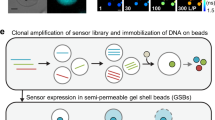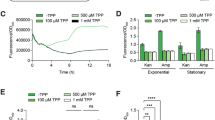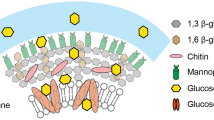Abstract
Optical sensors allow dynamic quantification of metabolite levels with subcellular resolution. Here we describe protocols for analyzing cytosolic glucose levels in yeast using genetically encoded Förster resonance energy transfer (FRET) sensors. FRET glucose sensors with different glucose affinities (Kd) covering the low nano- to mid- millimolar range can be targeted genetically to the cytosol or to subcellular compartments. The sensors detect the glucose-induced conformational change in the bacterial periplasmic glucose/galactose binding protein MglB using FRET between two fluorescent protein variants. Measurements can be performed with a single sensor or multiple sensors in parallel. In one approach, cytosolic glucose accumulation is measured in yeast cultures in a 96-well plate using a fluorimeter. Upon excitation of the cyan fluorescent protein (CFP), emission intensities of CFP and YFP (yellow fluorescent protein) are captured before and after glucose addition. FRET sensors provide temporally resolved quantitative data of glucose for the compartment of interest. In a second approach, reversible changes of cytosolic free glucose are measured in individual yeast cells trapped in a microfluidic platform, allowing perfusion of different solutions while FRET changes are monitored in a microscope setup. By using the microplate fluorimeter protocol, 96 cultures can be measured in less than 1 h; analysis of single cells of a single genotype can be completed in <2 h. FRET-based analysis has been performed with glucose, maltose, ATP and zinc sensors, and it can easily be adapted for high-throughput screening using a wide spectrum of sensors.
This is a preview of subscription content, access via your institution
Access options
Subscribe to this journal
Receive 12 print issues and online access
$259.00 per year
only $21.58 per issue
Buy this article
- Purchase on SpringerLink
- Instant access to full article PDF
Prices may be subject to local taxes which are calculated during checkout




Similar content being viewed by others
References
Bermejo, C. et al. In vivo biochemistry: quantifying ion and metabolite levels in individual cells or cultures of yeast. Biochem. J. 438, 1–10 (2011).
Okumoto, S., Takanaga, H. & Frommer, W.B. Quantitative imaging for discovery and assembly of the metabo-regulome. New Phytol. 180, 271–295 (2008).
Frommer, W.B., Davidson, M.W. & Campbell, R.E. Genetically encoded biosensors based on engineered fluorescent proteins. Chem. Soc. Rev. 38, 2833–2841 (2009).
Bermejo, C., Haerizadeh, F., Takanaga, H., Chermak, D. & Frommer, W.B. Dynamic analysis of cytosolic glucose and ATP levels in yeast using optical sensors. Biochem. J. 432, 399–406 (2010).
Kaper, T. et al. Nanosensor detection of an immunoregulatory tryptophan influx/kynurenine efflux cycle. PLoS Biol. 5, e257 (2007).
Miyawaki, A. et al. Fluorescent indicators for Ca2+ based on green fluorescent proteins and calmodulin. Nature 388, 882–887 (1997).
Chaudhuri, B. et al. Protonophore- and pH-insensitive glucose and sucrose accumulation detected by FRET nanosensors in Arabidopsis root tips. Plant J. 56, 948–962 (2008).
Chen, L.Q. et al. Sugar transporters for intercellular exchange and nutrition of pathogens. Nature 468, 527–532 (2010).
Kaper, T., Lager, I., Looger, L.L., Chermak, D. & Frommer, W.B. Fluorescence resonance energy transfer sensors for quantitative monitoring of pentose and disaccharide accumulation in bacteria. Biotechnol. Biofuels 1, 11 (2008).
Deuschle, K. et al. Rapid metabolism of glucose detected with FRET glucose nanosensors in epidermal cells and intact roots of Arabidopsis RNA-silencing mutants. Plant Cell 18, 2314–2325 (2006).
Chaudhuri, B., Hormann, F. & Frommer, W.B. Dynamic imaging of glucose flux impedance using FRET sensors in wild-type Arabidopsis plants. J. Exp. Bot. 62, 2411–2417 (2011).
Takanaga, H. & Frommer, W.B. Facilitative plasma membrane transporters function during ER transit. FASEB J. 24, 2849–2858 (2010).
Okumoto, S. et al. Detection of glutamate release from neurons by genetically encoded surface-displayed FRET nanosensors. Proc. Natl. Acad. Sci. USA 102, 8740–8745 (2005).
Hires, S.A., Zhu, Y. & Tsien, R.Y. Optical measurement of synaptic glutamate spillover and reuptake by linker optimized glutamate-sensitive fluorescent reporters. Proc. Natl. Acad. Sci. USA 105, 4411–4416 (2008).
Dulla, C. et al. Imaging of glutamate in brain slices using FRET sensors. J. Neurosci. Meth. 168, 306–319 (2008).
Allen, G.J. et al. Alteration of stimulus-specific guard cell calcium oscillations and stomatal closing in Arabidopsis det3 mutant. Science 289, 2338–2342 (2000).
Allen, G.J. et al. A defined range of guard cell calcium oscillation parameters encodes stomatal movements. Nature 411, 1053–1057 (2001).
Kerr, R. et al. Optical imaging of calcium transients in neurons and pharyngeal muscle of C. elegans. Neuron 26, 583–594 (2000).
Lütcke, H. et al. Optical recording of neuronal activity with a genetically-encoded calcium indicator in anesthetized and freely moving mice. Front. Neural Circ. 4, 9 (2010).
Hendel, T. et al. Fluorescence changes of genetic calcium indicators and OGB-1 correlated with neural activity and calcium in vivo and in vitro. J. Neurosci. 28, 7399–7411 (2008).
Tian, L. et al. Imaging neural activity in worms, flies and mice with improved GCaMP calcium indicators. Nat. Methods 6, 875–881 (2009).
Fehr, M., Frommer, W.B. & Lalonde, S. Visualization of maltose uptake in living yeast cells by fluorescent nanosensors. Proc. Natl. Acad. Sci. USA 99, 9846–9851 (2002).
Ha, J.S. et al. Design and application of highly responsive fluorescence resonance energy transfer biosensors for detection of sugar in living Saccharomyces cerevisiae cells. Appl. Environ. Microbiol. 73, 7408–7414 (2007).
Fehr, M., Lalonde, S., Ehrhardt, D.W. & Frommer, W.B. Live imaging of glucose homeostasis in nuclei of COS-7 cells. J. Fluoresc. 14, 603–609 (2004).
Qiao, W., Mooney, M., Bird, A.J., Winge, D.R. & Eide, D.J. Zinc binding to a regulatory zinc-sensing domain monitored in vivo by using FRET. Proc. Natl. Acad. Sci. USA 103, 8674–8679 (2006).
Hou, B.-H. et al. Optical sensors for monitoring dynamic changes of intracellular metabolite levels in mammalian cells. Nat. Protoc. 6, 1818–1833 (2011).
Lager, I., Fehr, M., Frommer, W.B. & Lalonde, S. Development of a fluorescent nanosensor for ribose. FEBS Lett. 553, 85–89 (2003).
Fehr, M., Lalonde, S., Lager, I., Wolff, M.W. & Frommer, W.B. In vivo imaging of the dynamics of glucose uptake in the cytosol of COS-7 cells by fluorescent nanosensors. J. Biol. Chem. 278, 19127–19133 (2003).
Deuschle, K. et al. Construction and optimization of a family of genetically encoded metabolite sensors by semirational protein engineering. Protein Sci. 14, 2304–2314 (2005).
Nagai, T. et al. A variant of yellow fluorescent protein with fast and efficient maturation for cell-biological applications. Nat. Biotech. 20, 87–90 (2002).
Griesbeck, O., Baird, G.S., Campbell, R.E., Zacharias, D.A. & Tsien, R.Y. Reducing the environmental sensitivity of yellow fluorescent protein. Mechanism and applications. J. Biol. Chem. 276, 29188–29194 (2001).
Takanaga, H., Chaudhuri, B. & Frommer, W.B. GLUT1 and GLUT9 as major contributors to glucose influx in HepG2 cells identified by a high sensitivity intramolecular FRET glucose sensor. Biochim. Biophys. Acta 1778, 1091–1099 (2008).
Schuetz, R., Kuepfer, L. & Sauer, U. Systematic evaluation of objective functions for predicting intracellular fluxes in Escherichia coli. Mol. Syst. Biol. 3, 119 (2007).
Zamboni, N., Fischer, E. & Sauer, U. FiatFlux—a software for metabolic flux analysis from 13C-glucose experiments. BMC Bioinform. 6, 209 (2005).
Niittylae, T., Chaudhuri, B., Sauer, U. & Frommer, W.B. Comparison of quantitative metabolite imaging tools and carbon-13 techniques for fluxomics. Methods Mol. Biol. 553, 355–372 (2009).
Wiechert, W., Schweissgut, O., Takanaga, H. & Frommer, W.B. Fluxomics: mass spectrometry versus quantitative imaging. Curr. Opin. Plant Biol. 10, 323–330 (2007).
Williams, D.A., Fogarty, K.E., Tsien, R.Y. & Fay, F.S. Calcium gradients in single smooth muscle cells revealed by the digital imaging microscope using Fura-2. Nature 318, 558–561 (1985).
Peterka, D.S., Takahashi, H. & Yuste, R. Imaging voltage in neurons. Neuron 69, 9–21 (2011).
Yoshioka, K. et al. A novel fluorescent derivative of glucose applicable to the assessment of glucose uptake activity of Escherichia coli. Biochim. Biophys. Acta 1289, 5–9 (1996).
Paredes, R.M., Etzler, J.C., Watts, L.T., Zheng, W. & Lechleiter, J.D. Chemical calcium indicators. Methods 46, 143–151 (2008).
Trapani, V. et al. Intracellular magnesium detection: imaging a brighter future. Analyst 135, 1855–1866 (2010).
Tomos, A.D. & Sharrock, R.A. Cell sampling and analysis (SiCSA): metabolites measured at single cell resolution. J. Exp. Bot. 52, 623–630 (2001).
Ebert, B. et al. Metabolic profiling of Arabidopsis thaliana epidermal cells. J. Exp. Bot. 61, 1321–1335 (2010).
MacDougall, A.J., Parker, R. & Selvendran, R.R. The use of nonaqueous fractionation to assess the ionic composition of the apoplast during fruit ripening. Plant Physiol. 108, 1679–1689 (1995).
Borner, S. et al. FRET measurements of intracellular cAMP concentrations and cAMP analog permeability in intact cells. Nat. Protoc. 6, 427–438 (2011).
Herbst, K.J., Allen, M.D. & Zhang, J. Luminescent kinase activity biosensors based on a versatile bimolecular switch. J. Am. Chem. Soc. 133, 5676–5679 (2011).
Hahn, K. Monitoring signaling processes in living cells using biosensors. Science's STKE 2003, tr5 (2003).
Esposito, A., Gralle, M., Dani, M.A., Lange, D. & Wouters, F.S. pHlameleons: a family of FRET-based protein sensors for quantitative pH imaging. Biochemistry 47, 13115–13126 (2008).
Violin, J.D., Zhang, J., Tsien, R.Y. & Newton, A.C. A genetically encoded fluorescent reporter reveals oscillatory phosphorylation by protein kinase C. J. Cell Biol. 161, 899–909 (2003).
DiPilato, L.M., Cheng, X. & Zhang, J. Fluorescent indicators of cAMP and Epac activation reveal differential dynamics of cAMP signaling within discrete subcellular compartments. Proc. Natl. Acad. Sci. USA 101, 16513–16518 (2004).
Sakai, R., Repunte-Canonigo, V., Raj, C.D. & Knöpfel, T Design and charaterization of a DNA-encoded, voltage-sensitive fluorescent protein. Eur. J. Neurosci. 13, 2314–2318 (2001).
Tsutsui, H., Higashijima, S., Miyawaki, A. & Okamura, Y Visualizing voltage dynamics in zebrafish heart. J. Physiol. 588, 2017–2021 (2010).
Grashoff, C. et al. Measuring mechanical tension across vinculin reveals regulation of focal adhesion dynamics. Nature 466, 263–466 (2010).
Bittner, C.X. et al. High resolution measurement of the glycolytic rate. Front. Neuroenerg. 2, pii: 26 (2010).
Tsutsui, H., Karasawa, S., Okamura, Y. & Miyawaki, A. Improving membrane voltage measurements using FRET with new fluorescent proteins. Nat. Methods 5, 683–685 (2008).
Rizzo, M.A., Springer, G.H., Granada, B. & Piston, D.W. An improved cyan fluorescent protein variant useful for FRET. Nat. Biotech. 22, 445–449 (2004).
Ai, H.W., Olenych, S.G., Wong, P., Davidson, M.W. & Campbell, R.E. Hue-shifted monomeric variants of Clavularia cyan fluorescent protein: identification of the molecular determinants of color and applications in fluorescence imaging. BMC Biol. 6, 13 (2008).
Hara, M. et al. Imaging endoplasmic reticulum calcium with a fluorescent biosensor in transgenic mice. Am. J. Physiol. Cell Physiol. 287, C932–C938 (2004).
Chen, D.C., Yang, B.C. & Kuo, T.T. One-step transformation of yeast in stationary phase. Curr. Genet. 21, 83–84 (1992).
Acknowledgements
This work was made possible by grants to W.B.F. from National Institutes of Health (National Institute of Diabetes and Digestive and Kidney Diseases; 1RO1DK079109). Frommer lab members are acknowledged for helpful discussions in the preparation of this protocol.
Author information
Authors and Affiliations
Contributions
C.B., F.H., H.T. and W.B.F. designed research; C.B., F.H., H.T. and D.C. performed research; C.B., F.H., H.T., D.C. and W.B.F. analyzed the data; C.B., F.H. and W.B.F. wrote the paper.
Corresponding author
Ethics declarations
Competing interests
The authors declare no competing financial interests.
Supplementary information
Supplementary Data 1
A data set of CFP and YFP variant intensities over time are located in the A-H columns of the spreadsheet. Background subtraction and ratios are calculated in the columns J-O of the spreadsheet. Columns P-V include the reorganized ratios over the time for the same culture. Normalization of the ratios is performed in columns X-AD. Graphs are displayed in columns AE-AK of the spreadsheet. Average of three different transformants and graphs are shown in columns AM-BA of the spreadsheet. (XLS 367 kb)
Rights and permissions
About this article
Cite this article
Bermejo, C., Haerizadeh, F., Takanaga, H. et al. Optical sensors for measuring dynamic changes of cytosolic metabolite levels in yeast. Nat Protoc 6, 1806–1817 (2011). https://doi.org/10.1038/nprot.2011.391
Published:
Issue Date:
DOI: https://doi.org/10.1038/nprot.2011.391
This article is cited by
-
Quantifying intracellular glucose levels when yeast is grown in glucose media
Scientific Reports (2023)
-
Spatiotemporal Imaging of Cellular Energy Metabolism with Genetically-Encoded Fluorescent Sensors in Brain
Neuroscience Bulletin (2018)
-
Quantitative characterization of the auxin-inducible degron: a guide for dynamic protein depletion in single yeast cells
Scientific Reports (2017)
-
Yeast factories for the production of aromatic compounds: from building blocks to plant secondary metabolites
Journal of Industrial Microbiology and Biotechnology (2016)
-
A sensor for quantification of macromolecular crowding in living cells
Nature Methods (2015)
Comments
By submitting a comment you agree to abide by our Terms and Community Guidelines. If you find something abusive or that does not comply with our terms or guidelines please flag it as inappropriate.



